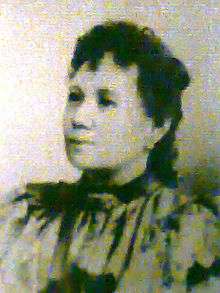Aniceto Lacson
Aniceto Lacson y Ledesma (April 17, 1857 – February 3, 1931) was a Filipino revolutionary general, sugar baron, and businessman.[1]:476 He is notable for leading the Negros Revolution along with Juan Araneta, and for being the President of the short-lived Republic of Negros.
Aniceto Lacson y Ledesma | |
|---|---|
 A young Aniceto Lacson | |
| President of the Republic of Negros | |
| In office November 5, 1898 – April 30, 1901 | |
| Preceded by | (post made) Colonel Isidro de Castro as the Spanish Military Governor of Negros |
| Succeeded by | Melecio Severino (as Civil Governor) |
| Personal details | |
| Born | April 17, 1857 Molo, Iloilo, Iloilo Province, Captaincy General of the Philippines |
| Died | February 3, 1931 (aged 73) Talisay, Negros Occidental, Philippine Islands |
Early life
Lacson was the fifth son of seven children of Lucio Petronila Lacson and Clara Ledesma of Iloilo who migrated to Negros when he was still young. His early education began under private tutelage in Molo, Iloilo. He later studied commerce at the Ateneo Municipal de Manila, where his classmates included future general and comrade Juan Araneta, José Rizal, and other Filipinos who later figured in the Philippine Revolution.
While a student in Manila, he had the opportunity to meet the founder of the Katipunan, Andrés Bonifacio, with whom he had a secret blood compact. He was the only Negrense who had this honor and consequently became a member of the revolutionary society.
Family

Aniceto first married Rosario Araneta, a direct descendant of the Kabungsuan royal family of Mindanao, daughter of Patricio Cabunsol Araneta and Leoncia Araneta, with whom he sired eleven children. They were:
- Jesusa, the eldest, married Jose Maria Arroyo y Pidal, her second cousin. Jesusa and Jose are the grandparents of Atty. Jose Miguel Arroyo, husband of President Gloria Macapagal-Arroyo
- Emilio
- Clotilde, both died at an early age
- Carmen, married Ricardo Claparols, a Spaniard
- Enriqueta, married Domingo Lacson III, a first cousin
- Isaac, who became governor of Negros, then congressman and senator of the Republic married Carmen Paterno
- Mariano, married Lilia Montilla
- Perfecta, married Santiago Franco
- José, died young
- Aniceto, Jr., married Aurora Lacson, a cousin
- Dominador, married Visitación Lacson, another cousin
With his second wife, Magdalena Torres, he had 10 children. They were:
- Resurección, married Carlos Sackermann
- Margarita, a former Miss Negros Occidental, married William Gemperle
- Leonila, married Angel Gamboa
- Leoncia, single born 6 December 1903, died 29 June 1981
- Nicolas, married Amparo Lacson, sister of Arsenio Lacson, Mayor of Manila, parents of the famous and controversial Rose Porteous of Perth, Australia
- Juan, married Reymunda Villareal
- José, married Estelita Adrias; had 6 sons- Aniceto, Jose Douglas, Rizal, William, Alex, Anthony
- Lucio, a Marine Engineer married to Consuelo Flores; had 6 daughters -Jennifer Lacson Snyder, Christie Lacson Eccleston, Kathleen Lacson Griffith, Vivienne Lacson Pascual, Grace Lacson Hosseini, May Lacson. He died in 1989.
- Luis, married Lily Distajo; had 8 daughters and 7 sons - Ma. Elena Lacson de Gracia( died at age 36), Ma. Luisa Lacson Marte, Ma. Carmen Lacson Escutin, Luis Distajo Lacson,
Manuel Distajo Lacson, Sebastian Distajo Lacson, Ma. Corazon Lacson Mirasol, her twin sister Ma. Gloria Distajo Lacson died when she was only 3 months old, Ma. Rita Lacson, Ana Maria Distajo Lacson, Aniceto Miguel Distajo Lacson, Jacinto Distajo Lacson, and Ma. Asuncion Distajo Lacson who died at age 50 on November 2, 2014
- Consuelo, married Sebastian Corro.
Properties
When his father became bedridden, Lacson took charge of all the work in the haciendas and did much to improve the properties. As a result, through his efforts his father became one of the richest men in Negros and the Philippines. When the time came to divide his father's properties his other brothers chose the best haciendas. He, for his part, chose the uncultivated ones. Thus, he received more land from his father than his brothers. Through hard work, he improved all the land and turned it into one of the best producing haciendas in Negros.
In the later 19th century, a Swiss businessman by the name of Luchinger decided to sell his vast properties in Matabang, Talisay, which he earlier purchased from Nicholas Loney, the biggest sugar cane producer in Negros at that time. It was offered to Aniceto Lacson, but he did not have enough ready cash. Luchinger was willing to sell it on installment but Aniceto's father Lucio refused as the venture appeared risky. Aniceto negotiated with Luchinger to agree to sell it to him without guarantor. Knowing that Aniceto was hardworking, honest and followed through with his business commitments, Luchinger agreed.
His home in Talisay City, Negros Occidental is owned by his descendants the Claparols family.
The Republic of Negros
The Spanish Governor of Negros Island, Isidro Castro, surrendered to forces under Aniceto Lacson and Juan Araneta at Bacolod on 6 Nov. 1898.[1]:476 The Cantonal Republic of Negros was established with Aniceto Lacson as its President from November 27, 1898, until March 4, 1899, when the Negros revolutionaries surrendered to the United States General James Francis Smith. The government lasted for three months and four days.
Ancestry
| Ancestors of Aniceto Lacson | |||||||||||||||||||||||||||||||||||||||||||||||||||||||||||||||||||||||||||||||||||||||||||||||||||||||||||||||||||||||||||||||||||||||||||||||||||||||||||||||||||||||||||||||||||||||||||||||||||||||||||||||||||||||||||||||||||||||||||||||||||||||||||||||||||||||||||||||||||||||||||||||||||||||||||||||||||||||||||||||||||||||||||||||||||||||||||||||||||||||||||||||||||||||||||||||||||||||||||||||||||||||||||||||||||||||||||||||||||||||||||||||||||||||||||||||||||
|---|---|---|---|---|---|---|---|---|---|---|---|---|---|---|---|---|---|---|---|---|---|---|---|---|---|---|---|---|---|---|---|---|---|---|---|---|---|---|---|---|---|---|---|---|---|---|---|---|---|---|---|---|---|---|---|---|---|---|---|---|---|---|---|---|---|---|---|---|---|---|---|---|---|---|---|---|---|---|---|---|---|---|---|---|---|---|---|---|---|---|---|---|---|---|---|---|---|---|---|---|---|---|---|---|---|---|---|---|---|---|---|---|---|---|---|---|---|---|---|---|---|---|---|---|---|---|---|---|---|---|---|---|---|---|---|---|---|---|---|---|---|---|---|---|---|---|---|---|---|---|---|---|---|---|---|---|---|---|---|---|---|---|---|---|---|---|---|---|---|---|---|---|---|---|---|---|---|---|---|---|---|---|---|---|---|---|---|---|---|---|---|---|---|---|---|---|---|---|---|---|---|---|---|---|---|---|---|---|---|---|---|---|---|---|---|---|---|---|---|---|---|---|---|---|---|---|---|---|---|---|---|---|---|---|---|---|---|---|---|---|---|---|---|---|---|---|---|---|---|---|---|---|---|---|---|---|---|---|---|---|---|---|---|---|---|---|---|---|---|---|---|---|---|---|---|---|---|---|---|---|---|---|---|---|---|---|---|---|---|---|---|---|---|---|---|---|---|---|---|---|---|---|---|---|---|---|---|---|---|---|---|---|---|---|---|---|---|---|---|---|---|---|---|---|---|---|---|---|---|---|---|---|---|---|---|---|---|---|---|---|---|---|---|---|---|---|---|---|---|---|---|---|---|---|---|---|---|---|---|---|---|---|---|---|---|---|---|---|---|---|---|---|---|---|---|---|---|---|---|---|---|---|---|---|---|---|---|---|---|---|---|---|---|---|---|---|---|---|---|---|---|---|---|---|---|---|---|---|---|---|---|---|---|---|---|---|---|---|---|---|---|---|---|---|---|---|---|---|---|---|---|---|---|---|---|---|---|---|---|---|---|---|---|---|---|---|---|---|---|---|---|---|---|---|---|---|---|---|---|---|---|---|---|---|---|---|---|
| |||||||||||||||||||||||||||||||||||||||||||||||||||||||||||||||||||||||||||||||||||||||||||||||||||||||||||||||||||||||||||||||||||||||||||||||||||||||||||||||||||||||||||||||||||||||||||||||||||||||||||||||||||||||||||||||||||||||||||||||||||||||||||||||||||||||||||||||||||||||||||||||||||||||||||||||||||||||||||||||||||||||||||||||||||||||||||||||||||||||||||||||||||||||||||||||||||||||||||||||||||||||||||||||||||||||||||||||||||||||||||||||||||||||||||||||||||
See also
- Negros Revolution
- Silay City
- Bacolod
References
- Foreman, J., 1906, The Philippine Islands, A Political, Geographical, Ethnographical, Social and Commercial History of the Philippine Archipelago, New York: Charles Scribner's Sons
External links
| Political offices | ||
|---|---|---|
| New title Republic established |
President of the Republic of Negros | Succeeded by Melecio Severino as Civil Governor of Negros Island |